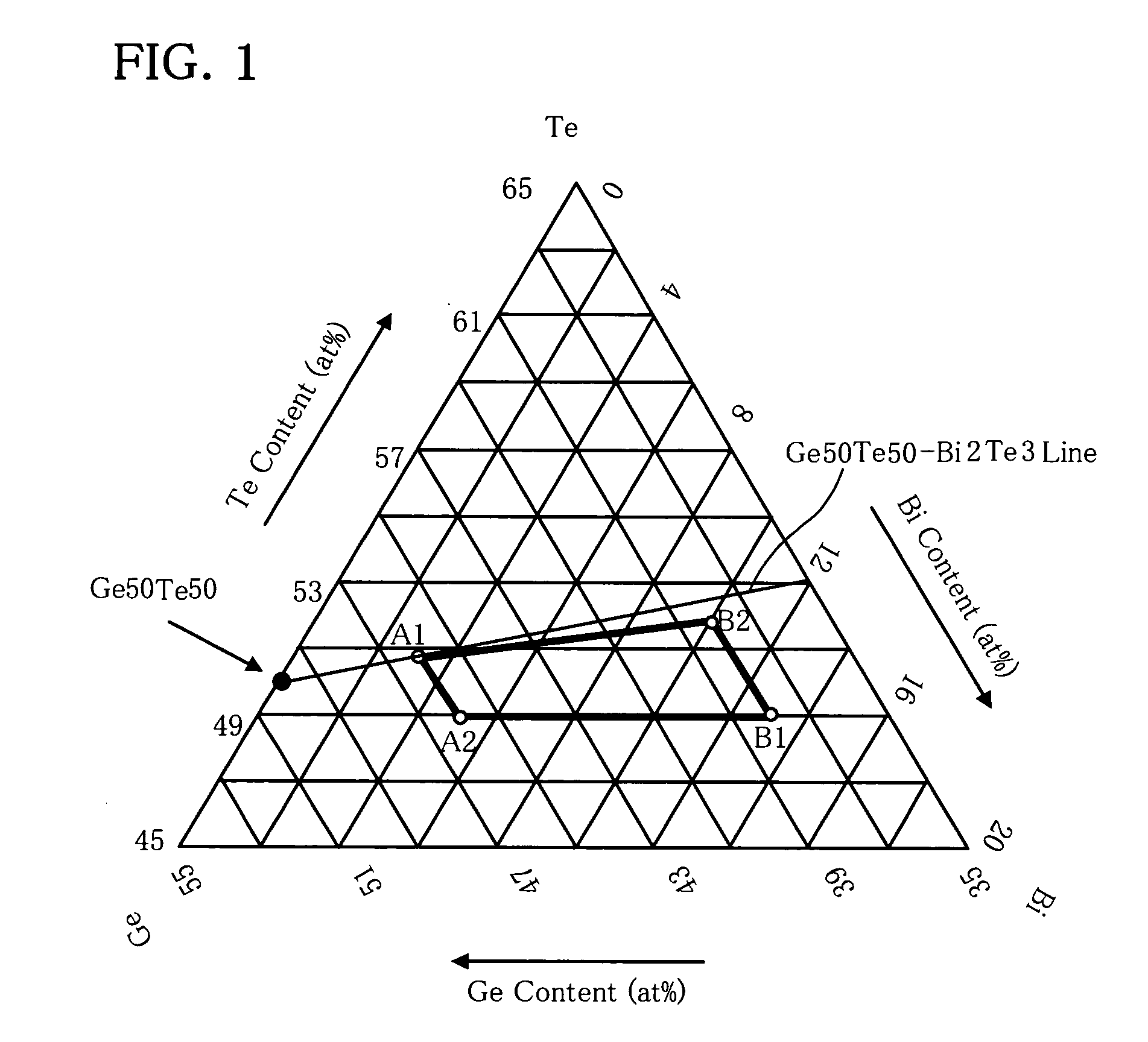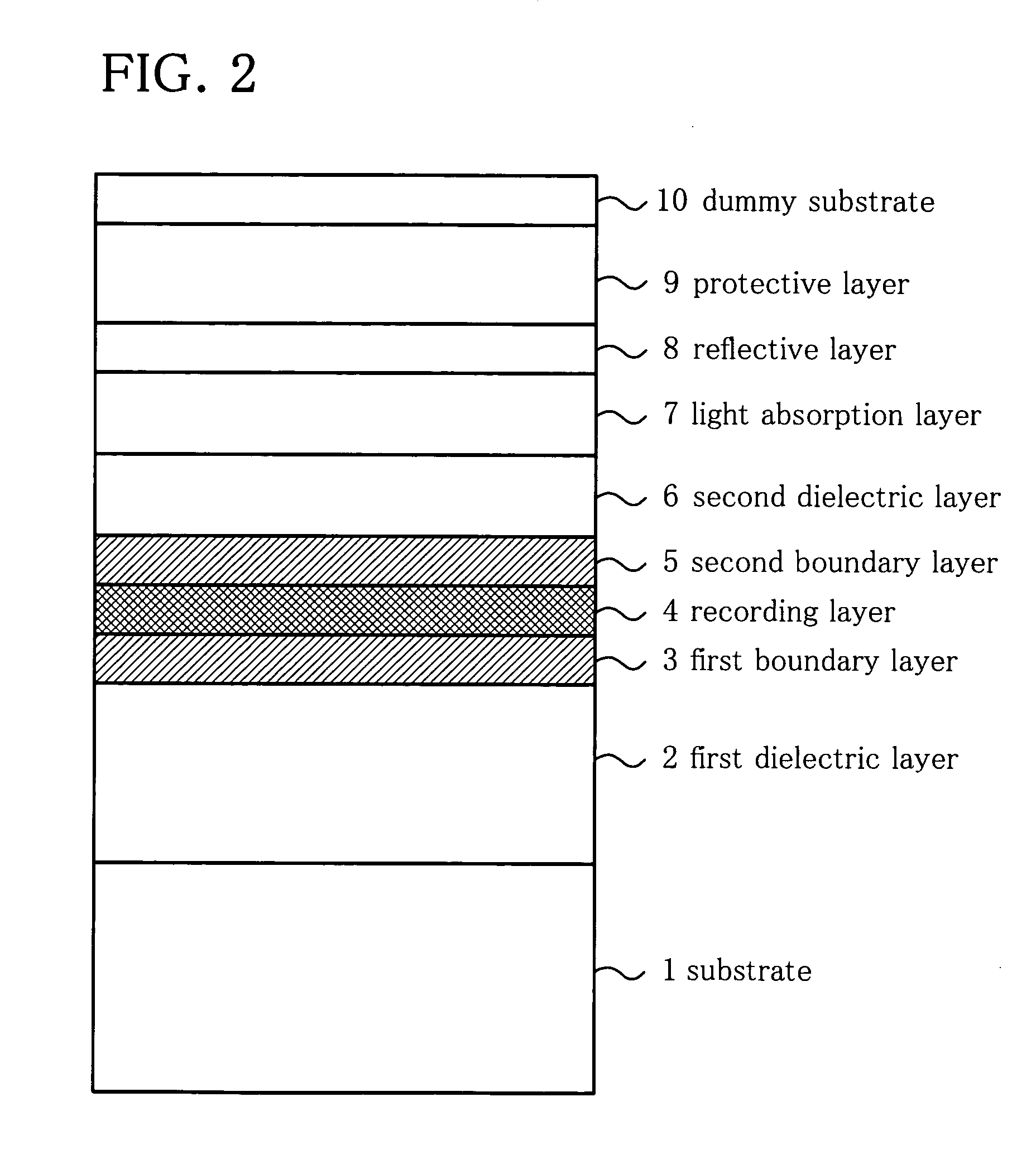Information recording medium
a technology of information recording and recording medium, which is applied in the field of information recording medium, can solve the problems of difficult to obtain excellent rewrite resistance and shelf life, and achieve the effect of excellent multiple rewrite performance and excellent shelf li
- Summary
- Abstract
- Description
- Claims
- Application Information
AI Technical Summary
Benefits of technology
Problems solved by technology
Method used
Image
Examples
example
Example 1
(Preparation of Information Recording Medium)
[0049] First, in order to study phase-change recording layer materials with which CAV recording can be realized in a wide range from low-speed recording to high-speed recording, a disk having the structure shown in FIG. 1 was prepared as follows.
[0050] On a polycarbonate substrate 1 of 120 mm in diameter and 0.6mm in thickness, first, a material made of (ZnS) (80)-(SiO2) (20) mol % was formed as the first dielectric layer 2 to a film thickness of 150 nm, using a sputtering system which has a plurality of sputtering chambers and which has a small distribution of film thicknesses and a high reproducibility. Subsequently, a material made of Cr2O3 was formed as the first boundary layer 3 to a film thickness of 2 nm, and a material made of Bi—Ge—Te was formed as the recording layer 4 thereon to a film thickness of 9 nm. As for a method of forming Bi—Ge—Te, two targets were attached to the inside of one sputtering chamber, one of w...
example 2
[0077] In this example, in order to study Cr—Ta—O composition in relation to crystallization speeds on inner and outer tracks of an information recording medium, Bi7Ge43Te50(at %) was adopted as a recording layer composition as in example 1, and Cr(20)Ta(14)O(66) was adopted as a first boundary layer composition. For a second boundary layer, as a method of controlling the Ta amount ratio between inner and outer tracks, the Ta content was selectively increased in a peripheral portion by using a Cr—Ta—O target having a target size different from that of a Cr2O3 target. The range of the Ta / Cr composition ratio of the second boundary layer used this time was set as y / x=0.05 for an inner track based on the result obtained in example 1, where the Ta / Cr composition ratio is represented by CrxTay. For an outer track, the range of the Ta / Cr composition ratio of the second boundary layer used this time is set as follows.
CrxTay (0.05≦y / x≦0.7)
[0078] An evaluation method will be described. Usi...
example 3
[0091] In this example, in order to study a boundary layer thickness which is excellent in multiple-rewrite performance and excellent in shelf life under a humidified environment, an optical information recording medium was prepared, using Bi7Ge43Te50 (at %) for the recording layer composition as in example 1, and using Cr(20)Ta(14)O(66) and Cr(37)Ta(2)O(61) for the first and second boundary layer compositions respectively.
[0092] A method of preparing the information recording medium is similar to that of example 1. The film thickness of the first boundary layer was changed in the range of 0 nm to 30.0 nm, and that of the second boundary layer was constant, 2 nm.
[0093] Next, as for evaluation in an information recording apparatus, information was rewritten multiple times (repeated recording) at a high linear velocity of 20.5 m / s, and jitter after 80 thousand rewrites was evaluated. A target value of jitter after 80 thousand rewrites is 14% or less. Note that multiple-rewrite evalu...
PUM
| Property | Measurement | Unit |
|---|---|---|
| thickness | aaaaa | aaaaa |
| thickness | aaaaa | aaaaa |
| temperature | aaaaa | aaaaa |
Abstract
Description
Claims
Application Information
 Login to View More
Login to View More - R&D
- Intellectual Property
- Life Sciences
- Materials
- Tech Scout
- Unparalleled Data Quality
- Higher Quality Content
- 60% Fewer Hallucinations
Browse by: Latest US Patents, China's latest patents, Technical Efficacy Thesaurus, Application Domain, Technology Topic, Popular Technical Reports.
© 2025 PatSnap. All rights reserved.Legal|Privacy policy|Modern Slavery Act Transparency Statement|Sitemap|About US| Contact US: help@patsnap.com


